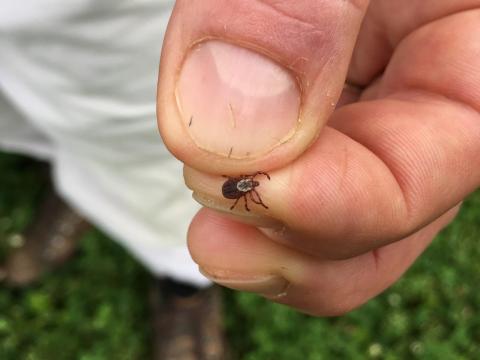Ohio is crawling with ticks. What can be done to stop their spread?

Listen to this Episode
Last month, health officials across Appalachian Ohio gathered for the region’s inaugural summit on infectious diseases. It focused on a tiny arachnid that poses a huge threat: ticks.
Since 2010, Ohio has seen a 35-fold increase in cases of Lyme disease. And the spread isn’t slowing down. Ohio residents reported nearly 1,300 cases of the disease last year — more than double the year before.
“We’re not seeing a linear increase in cases,” said Ohio State assistant professor and tick expert Tim McDermott, “we’re seeing an exponential increase in cases.”
Why are tick-borne diseases spreading in Ohio?
McDermott says the dramatic rise of tick-borne diseases in Ohio is happening for a combination of reasons.
First, there are more ticks in the state.
Because of factors like climate change and reforestation, Ohio has more habitat for ticks than it did just a few decades ago. As a result, ticks are thriving here, McDermott said.
“Ohio is really on the forefront of tick expansion,” he said. “We went from one tick of medical importance to humans, companion animals and livestock 20 years ago, which was the American dog tick, to five nowadays, including adding two new ticks in just the last few years.”
Plus, a lot of those ticks are carrying diseases.
“We have counties where something like 40 to 60% of ticks carry disease now,” McDermott said. “So, your chances of getting a disease are very high.”
These days, public health officials and physicians are more aware of tick-borne diseases and better able to test for them, so that’s leading to higher numbers of reported cases too.
“It’s a combination,” McDermott said. “We're seeing a definite expansion, but we're also looking for [tick-borne diseases] better.”
Advancements in tick prevention medicine
Ticks have expanded so rapidly in Ohio, McDermott said research into the parasite hasn’t kept up.
“When we look at the medications that are available to keep companion animals safe, they have great stuff. They have any number of things they can use that are very, very effective,” he said. “But when we look at what we have for cattle, they're using the same stuff now that they used 20, 30, 40 years ago. And the same thing with people.”
Advice for how to prevent tick bites has been the same for decades, McDermott said: wear long-sleeves and light colors, use bug spray and do tick checks.
Those are still effective measures, he said, but he’s hopeful there will be better options to prevent and treat tick-borne diseases in the future.
“I've seen some really promising research for vaccines, for some alternate tick preventatives and even a lot of research looking at tick behaviors, the enzymes they have and the immunological response that the body has for ticks, trying to figure out how we can make ourselves stronger against ticks.”
It could be a while until that research comes to fruition though, and in the meantime, McDermott doesn’t see the spread of tick-borne diseases slowing down.
“I think we’re going to really have this on our radar for the foreseeable future,” he said.
9(MDYwODMwNTczMDE2ODk5NTExNDAyNzM5Ng000))
- Home
- Schedules
- TV
- TV
- Local TV Programs
- Business | Life 360 with Kristi K.
- Toledo Stories
- To The Point with Doni Miller
- Listening with Keith Burris
- Ideas & Insights
- WGTE Presents
- BL360: Northwest Ohio Innovation Consortium
- Magic of the Old West End
- Freedom Means Never Surrender
- I&I: The Random Factor
- FF: National Cherry Festival
- TTP: Moms Demand Action For Gun Sense in America
- Watch Live
- Radio
- Education
- Community
- Support
- About
- Donate
- Watch Live


